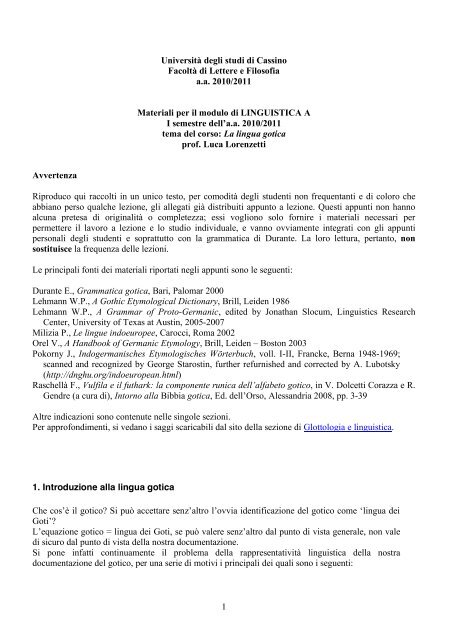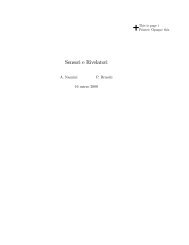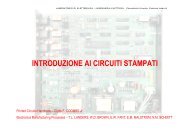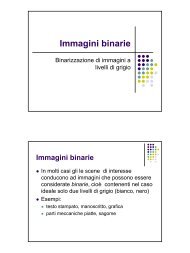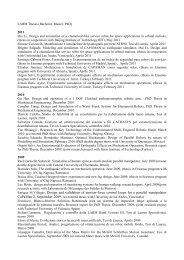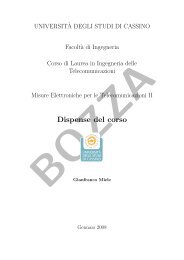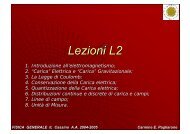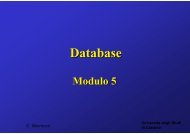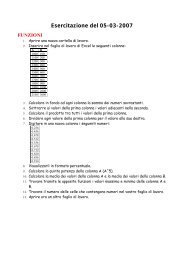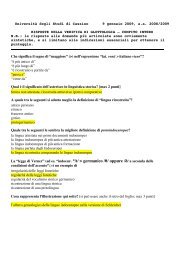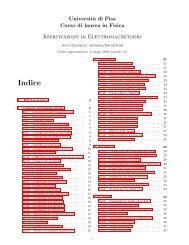Qui - Università degli Studi di Cassino
Qui - Università degli Studi di Cassino
Qui - Università degli Studi di Cassino
You also want an ePaper? Increase the reach of your titles
YUMPU automatically turns print PDFs into web optimized ePapers that Google loves.
Avvertenza<br />
<strong>Università</strong> <strong>degli</strong> stu<strong>di</strong> <strong>di</strong> <strong>Cassino</strong><br />
Facoltà <strong>di</strong> Lettere e Filosofia<br />
a.a. 2010/2011<br />
Materiali per il modulo <strong>di</strong> LINGUISTICA A<br />
I semestre dell’a.a. 2010/2011<br />
tema del corso: La lingua gotica<br />
prof. Luca Lorenzetti<br />
Riproduco qui raccolti in un unico testo, per como<strong>di</strong>tà <strong>degli</strong> studenti non frequentanti e <strong>di</strong> coloro che<br />
abbiano perso qualche lezione, gli allegati già <strong>di</strong>stribuiti appunto a lezione. Questi appunti non hanno<br />
alcuna pretesa <strong>di</strong> originalità o completezza; essi vogliono solo fornire i materiali necessari per<br />
permettere il lavoro a lezione e lo stu<strong>di</strong>o in<strong>di</strong>viduale, e vanno ovviamente integrati con gli appunti<br />
personali <strong>degli</strong> studenti e soprattutto con la grammatica <strong>di</strong> Durante. La loro lettura, pertanto, non<br />
sostituisce la frequenza delle lezioni.<br />
Le principali fonti dei materiali riportati negli appunti sono le seguenti:<br />
Durante E., Grammatica gotica, Bari, Palomar 2000<br />
Lehmann W.P., A Gothic Etymological Dictionary, Brill, Leiden 1986<br />
Lehmann W.P., A Grammar of Proto-Germanic, e<strong>di</strong>ted by Jonathan Slocum, Linguistics Research<br />
Center, University of Texas at Austin, 2005-2007<br />
Milizia P., Le lingue indoeuropee, Carocci, Roma 2002<br />
Orel V., A Handbook of Germanic Etymology, Brill, Leiden – Boston 2003<br />
Pokorny J., Indogermanisches Etymologisches Wörterbuch, voll. I-II, Francke, Berna 1948-1969;<br />
scanned and recognized by George Starostin, further refurnished and corrected by A. Lubotsky<br />
(http://dnghu.org/indoeuropean.html)<br />
Raschellà F., Vulfila e il futhark: la componente runica dell’alfabeto gotico, in V. Dolcetti Corazza e R.<br />
Gendre (a cura <strong>di</strong>), Intorno alla Bibbia gotica, Ed. dell’Orso, Alessandria 2008, pp. 3-39<br />
Altre in<strong>di</strong>cazioni sono contenute nelle singole sezioni.<br />
Per approfon<strong>di</strong>menti, si vedano i saggi scaricabili dal sito della sezione <strong>di</strong> Glottologia e linguistica.<br />
1. Introduzione alla lingua gotica<br />
Che cos’è il gotico? Si può accettare senz’altro l’ovvia identificazione del gotico come ‘lingua dei<br />
Goti’?<br />
L’equazione gotico = lingua dei Goti, se può valere senz’altro dal punto <strong>di</strong> vista generale, non vale<br />
<strong>di</strong> sicuro dal punto <strong>di</strong> vista della nostra documentazione.<br />
Si pone infatti continuamente il problema della rappresentatività linguistica della nostra<br />
documentazione del gotico, per una serie <strong>di</strong> motivi i principali dei quali sono i seguenti:<br />
1
1) lingua a corpus limitato:<br />
— limitazioni del corpus riguardano la quantità dei testi ma anche e soprattutto la qualità, in<br />
vari sensi:<br />
o genere testuale: es. l’etrusco e le altre lingue dell’Italia antica, con iscrizioni solo<br />
funerarie o <strong>di</strong> possesso; o il greco miceneo, con iscrizioni solo contabili e<br />
amministrative;<br />
o estensione cronologica dei testi: la storia della lingua gotica è inattingibile, visto che<br />
non posse<strong>di</strong>amo testi <strong>di</strong>stribuiti lungo un arco <strong>di</strong> tempo tale da permettere <strong>di</strong><br />
registrare evoluzioni linguistiche sistematiche o comunque <strong>di</strong> rilievo;<br />
— il gotico, come è stato detto più volte da molti stu<strong>di</strong>osi, è essenzialmente la lingua <strong>di</strong> un solo<br />
uomo e <strong>di</strong> un solo testo: il vescovo Wulfila (var. Vulfila, Ulfila) e la sua traduzione della<br />
Bibbia.<br />
2) lingua attestata in un testo <strong>di</strong> traduzione:<br />
ciò comporta per l’autore del testo una serie continua <strong>di</strong> scelte, tanto più impegnative quanto<br />
maggiore è la <strong>di</strong>fferenza <strong>di</strong> elaborazione tra la lingua <strong>di</strong> partenza e quella <strong>di</strong> arrivo.<br />
Se si pensa che parliamo<br />
a) della Bibbia, cioè un testo <strong>di</strong> grande circolazione;<br />
b) del greco, la maggiore lingua <strong>di</strong> cultura dell’Europa orientale;<br />
c) e del gotico, una lingua che è molto <strong>di</strong>fficile immaginare come dotata <strong>di</strong> una koinè<br />
omogenea, poiché non corrispondeva a una comunità omogenea ma a un insieme <strong>di</strong> tribù dai<br />
rapporti politici travagliati;<br />
possiamo immaginare il tipo <strong>di</strong> problemi che ci troveremo <strong>di</strong> fronte.<br />
Esempi:<br />
→ boka ‘lettera dell’alfabeto’ e il suo derivato bokareis ‘scriba’ traducono rispettivamente gr.<br />
grámma e grammateûs, concetti precedentemente ignoti alla cultura gotica, com’è ovvio visto che il<br />
gotico prima <strong>di</strong> Wulfila era solo una lingua parlata, non anche scritta.<br />
→ þiu<strong>di</strong>nassus e þiudangar<strong>di</strong> traducono il gr. basileía ‘regno’ (cf. gr. basileûs ‘re’). I due lessemi<br />
con<strong>di</strong>vidono un elemento, þiudans ‘re’ (der. da þiuda, cfr, ted. deutsch, antico umbro tuta<br />
‘citta<strong>di</strong>nanza’) e si <strong>di</strong>stinguono per l’altro, –assu- vs. –gard-. Formalmente, þiu<strong>di</strong>nassus è un<br />
derivato <strong>di</strong> þiudans e -assu-, suffisso che forma nomi astratti a partire da verbi, nomi o aggettivi (ad<br />
es. ibna ‘uguale’ > ibnassus ‘uguaglianza’).<br />
þiudangar<strong>di</strong> invece è un composto <strong>di</strong> þiudans con gards ‘casa, corte, giar<strong>di</strong>no’, imparentato con<br />
ingl. yard e lat. hortus. Una <strong>di</strong>fferenza <strong>di</strong> significato pertanto esiste: nel primo caso si tratta <strong>di</strong><br />
‘regno’ nel senso <strong>di</strong> ‘azione del regnare, dominio’, nel secondo si tratta invece <strong>di</strong> un ‘regno’<br />
concreto, <strong>di</strong> un ‘reame’. <strong>Qui</strong> una <strong>di</strong>stinzione semantica presente ma non lessicalizzata nel testo<br />
originale viene sottolineata tramite l’impiego <strong>di</strong> due lessemi <strong>di</strong>versi, seppur morfologicamente<br />
connessi, in un processo traduttivo tutto interno al versante gotico del rapporto linguistico.<br />
3) lingua priva <strong>di</strong> una tra<strong>di</strong>zione scritta, la quale inizia proprio col testo in questione: situazione<br />
<strong>di</strong>ffusa, ovviamente, ma che crea problemi, tipologicamente ben noti ma comunque da risolvere:<br />
— esempi dell’alfabeto greco > etrusco > latino: H = [ɛ] vs [h], X = [x] vs [ks] eccetera<br />
— Wulfila creatore dell’alfabeto gotico; germanico scritto in precedenza con alfabeto runico<br />
— Importanza linguistica e storico-letteraria-culturale per la germanistica<br />
2
— Importanza linguistica comparativa per l’indoeuropeistica, a causa soprattutto<br />
dell’attestazione relativamente antica. <strong>Stu<strong>di</strong></strong>osi importanti hanno considerato il gotico per i<br />
primi tentativi <strong>di</strong> comparazione della linguistica scientifica:<br />
o ad esempio, Rasmus Rask, nel suo saggio famoso del 1814 (Ricerche sull’origine<br />
della lingua nor<strong>di</strong>ca antica o islandese), intitola il secondo capitolo Om Islandsken<br />
og den Gotiske Sprogklasse, cioè «Sulla classificazione linguistica dell’islandese e<br />
del gotico»<br />
2. Fonti e strumenti per la conoscenza della lingua gotica<br />
Il corpus testuale del gotico, inteso come testi <strong>di</strong> qualsiasi estensione prodotti in lingua gotica, è<br />
costituito dai seguenti documenti <strong>di</strong>retti:<br />
1. traduzioni e commenti della Bibbia<br />
2. altri documenti vari (contratti, calendari, alfabeti)<br />
3. forme del gotico <strong>di</strong> Crimea<br />
a questo corpus si aggiungono i documenti in<strong>di</strong>retti, costituiti da<br />
4. forme gotiche latinizzate<br />
5. elementi gotici in altre lingue (romanze e slave; albanese; iraniche)<br />
1. TRADUZIONI e COMMENTI DELLA BIBBIA<br />
La maggior parte della documentazione del gotico consiste in traduzioni bibliche risalenti al IV secolo.<br />
Perlopiù si tratta <strong>di</strong> frammenti <strong>di</strong> Vangeli e delle Lettere <strong>di</strong> Paolo; l’unico frammento del Vecchio<br />
testamento sono alcuni brani dai capitoli 5, 6 e 7 del libro <strong>di</strong> Neemia.<br />
I manoscritti sono del VI secolo, al massimo della fine del V, sicché almeno un secolo e mezzo separa la<br />
traduzione <strong>di</strong> Wulfila dalla sua tra<strong>di</strong>zione.<br />
I co<strong>di</strong>ci che ci tramandano la traduzione <strong>di</strong> Wulfila sono stati redatti probabilmente in Italia: alcune<br />
varianti paleografiche potrebbero rinviare a redazioni <strong>di</strong>versamente localizzate (ad es. i <strong>di</strong>versi tipi <strong>di</strong><br />
, latina o greca), ma storicamente ciò che interessa è che la humus culturale e storica che giustifica la<br />
tra<strong>di</strong>zione della Bibbia gotica in Italia è certo da in<strong>di</strong>viduare nel regno <strong>di</strong> Teodorico.<br />
La traduzione gotica della Bibbia è apparentemente basata su una versione del testo greco, allora<br />
dominante nella <strong>di</strong>ocesi <strong>di</strong> Costantinopoli, che però non è sopravvissuta. Ci sono anche tracce evidenti<br />
<strong>di</strong> influenza da traduzioni latine della Bibbia <strong>di</strong> epoca pre-Vulgata.<br />
Dei co<strong>di</strong>ci che contengono la traduzione gotica della Bibbia, il più importante è il Codex argenteus. Il<br />
nome deriva dalla legatura, che è d’argento. Esso contiene 187 fogli, su circa 336 dell’originale. Le<br />
pagine sono in pergamena purpurea con lettere d’oro e d’argento. Gli inizi dei Vangeli, le prime righe<br />
delle sezioni e il pater noster sono tutti a lettere d’oro, il resto è scritto in argento. Il co<strong>di</strong>ce è stato<br />
scoperto nell’Abbazia <strong>di</strong> Werden nel XVI secolo ed è conservato oggi nella biblioteca dell’<strong>Università</strong> <strong>di</strong><br />
3
Uppsala. Un foglio del co<strong>di</strong>ce è stato scoperto nel 1970 nella cattedrale <strong>di</strong> Speyer sul Reno.<br />
Il Codex Gissensis è stato trovato in Egitto nel 1907. Consisteva in quattro pagine contenenti versetti <strong>di</strong><br />
Luca, 23-24 in latino e gotico.<br />
Il Codex carolinus è un palinsesto composto da 4 foglie e contenenti versetti della Lettera ai Romani in<br />
latino e gotico. È stato trovato nella abbazia <strong>di</strong> Weissenburg, anche se in origine apparteneva al<br />
monastero <strong>di</strong> Bobbio in Liguria. Risiede nella biblioteca <strong>di</strong> Wolfenbüttel.<br />
I cinque Co<strong>di</strong>ci Ambrosiani sono palinsesti:<br />
— il co<strong>di</strong>ce A contiene 102 fogli, <strong>di</strong> cui 6 sono bianchi e uno illeggibile. Questo contiene vari brani<br />
delle lettere <strong>di</strong> Paolo e una pagina con frammenti <strong>di</strong> un calendario.<br />
— Il Co<strong>di</strong>ce B contiene 78 fogli, che hanno il testo completo della seconda lettera ai Corinzi e parti<br />
<strong>di</strong> altre lettere paoline.<br />
— Il Co<strong>di</strong>ce C ha due fogli, contenenti Matteo 25-27.<br />
— Il Co<strong>di</strong>ce D contiene 3 fogli con i suddetti brani dai capitoli 5, 6 e 7 del libro <strong>di</strong> Neemia.<br />
— L’ultimo dei Co<strong>di</strong>ci Ambrosiani, il Co<strong>di</strong>ce E, contiene otto fogli. In questi è conservato un<br />
documento cui è stato dato dal suo primo e<strong>di</strong>tore (Massmann 1834) il titolo Skeireins<br />
aiwaggeljons þairh Iohannen ['skirins 'ɛwaŋgeljons 'θɛrh 'johannen] cioè ‘Spiegazione del<br />
Vangelo secondo Giovanni’; questo testo oggi è detto semplicemente la Skeireins ['skirins].<br />
2. ALTRI DOCUMENTI<br />
I co<strong>di</strong>ci già citati, più alcuni altri, conservano inoltre:<br />
— un frammento <strong>di</strong> un calendario <strong>di</strong> martiri,<br />
— note marginali in un manoscritto veronese,<br />
— un atto notarile latino da Ravenna scritto intorno al 551,<br />
— un altro atto notarile latino da Arezzo, poi perduto,<br />
— un alfabeto gotico con i nomi delle lettere, vergato su un manoscritto <strong>di</strong> Alcuino<br />
— trascrizioni <strong>di</strong> numeri in un manoscritto austriaco del secolo IX-X.<br />
3. IL GOTICO DI CRIMEA<br />
In una lettera dal <strong>di</strong>plomatico fiammingo Ogier Ghislain de Busbecq sono contenute le tracce più recenti<br />
della lingua gotica.<br />
La lettera descrive l’incontro dell’estensore, avvenuto tra il 1555 e il 1562, con due inviati <strong>di</strong>plomatici<br />
dalla Crimea che parlavano una lingua che si pensa possa essere una varietà <strong>di</strong> gotico.<br />
La lettera è scritta in latino e contiene però un elenco, a mo’ <strong>di</strong> glossario, consistente <strong>di</strong> un’ottantina <strong>di</strong><br />
parole isolate. La tra<strong>di</strong>zione <strong>di</strong> questo testo è molto travagliata già in partenza:<br />
a) uno <strong>degli</strong> informanti era certamente <strong>di</strong> lingua greca; non è certo se l’altro fosse <strong>di</strong> madrelingua<br />
germanica o solo bilingue; quin<strong>di</strong> l’atten<strong>di</strong>bilità linguistica <strong>degli</strong> informanti è limitata;<br />
b) il trascrittore evidentemente fraintende in vari punti il dettato;<br />
c) i copisti che ci hanno tramandato il documento hanno aggiunto errori propri;<br />
d) il carattere germanico delle forme trasmesse pare fuori <strong>di</strong>scussione. Tuttavia, i tratti <strong>di</strong>stintivi del<br />
gotico rispetto al resto del germanico, già scarsi per la lingua <strong>di</strong> Wulfila e perlopiù consistenti in<br />
isoglosse <strong>di</strong> conservazione, sono ancor più <strong>di</strong>fficili da riscontrare in queste forme, che potrebbero<br />
appartenere a una lingua nel frattempo evolutasi.<br />
Per questi motivi, la reale consistenza linguistica e soprattutto la reale ascrivibilità del presunto gotico <strong>di</strong><br />
Crimea al gruppo germanico orientale restano almeno parzialmente in <strong>di</strong>scussione.<br />
4
4. LE FORME GOTICHE NEI TESTI LATINI MEDIEVALI<br />
Abbiamo già visto come si debba <strong>di</strong>stinguere tra notizie in gotico e notizie sul gotico. In particolare,<br />
appartengono a questa seconda tipologia vari importanti testi tra tardo antico e alto me<strong>di</strong>oevo. Il più<br />
ricco linguisticamente si deve a Iordanes (Giordano, Giordane), che scrisse il De origine actibusque<br />
Getarum, anche noto come Getica, datato al 551. L’opera riprende, come <strong>di</strong>chiara lo stesso autore, i<br />
Libri XII De Rebus Gestis Gothorum <strong>di</strong> Cassiodoro, lavoro poi perduto; ma deriva la sua importanza<br />
soprattutto dal fatto che Iordanes è l’unico Goto a scrivere <strong>di</strong> cose gotiche, e conosce quin<strong>di</strong> <strong>di</strong> prima<br />
mano la lingua e la cultura che descrive.<br />
Esempi delle glosse gotiche nei Getica sono<br />
— Baltha id est audax (29, 146): cfr it. baldo (che però <strong>di</strong>pende prob. da un interme<strong>di</strong>ario<br />
ant.franc. bald, baud < francone baldh, e non <strong>di</strong>rettamente dal got. balþs).<br />
— proceres suos semideos id est ansis vocabant (13, 78): il riferimento è agli Asi, gli dèi<br />
germanici che presiedevano alla funzione bellica e a quella giuri<strong>di</strong>ca (capeggiati da O<strong>di</strong>no e<br />
Thor), contrapposti nella mitologia nor<strong>di</strong>ca ai Vani, dèi della fertilità (Njörd e i suoi figli<br />
Freyr e Freya).<br />
5. I PRESTITI GOTICI NELLE ALTRE LINGUE<br />
Si tratta delle parole gotiche entrate e conservatesi nelle varie lingue i cui parlanti sono venuti in qualche<br />
modo a contatto col gotico: voci come il paleosl. kladȩdzĭ ‘pozzo’ < prob. got. *kal<strong>di</strong>ggs; paleosl. xlěbŭ,<br />
russo xleb, ucr. xlib < got. hlaifs eccetera; alb. shkulkë ‘staccionata per il pascolo, fatta <strong>di</strong> rami’ < got.<br />
skulka ‘guar<strong>di</strong>ano’, cfr. it. scolta; it. albergo fr. auberge prov. auberc sp. port. albergue < gmc *haribergō,<br />
cfr. ted. mod. Herberge.<br />
Altre in<strong>di</strong>cazioni e materiali su questo tema infra.<br />
STRUMENTI BIBLIOGRAFICI PER LO STUDIO DEL GOTICO<br />
Bibliografia:<br />
Alle in<strong>di</strong>cazioni offerte da Durante, Grammatica gotica, pp. 189-190, va aggiunto almeno il<br />
<strong>di</strong>zionario etimologico <strong>di</strong><br />
Winfred P. Lehmann, A Gothic Etymological Dictionary, based on the third e<strong>di</strong>tion of<br />
Vergleichendes Wörterbuch der Gotischen Sprache by Sigmund Feist, Leiden, Brill 1986.<br />
Risorse online:<br />
I siti che danno notizie sulla lingua gotica, o contengono parti e commenti testuali alla traduzione <strong>di</strong><br />
Wulfila sono numerosi, ma non tutti dello stesso livello <strong>di</strong> controllo scientifico. Ve ne sono però<br />
alcuni, ospitati o gestiti da accademici o stu<strong>di</strong>osi <strong>di</strong> livello universitario, che possono essere<br />
senz’altro presi in considerazione, soprattutto per la possibilità che essi offrono <strong>di</strong> lavorare<br />
<strong>di</strong>rettamente sui facsimile dei testi. Li elenco qui <strong>di</strong> seguito:<br />
http://www.ub.uu.se/sv/Samlingar/Handskrifter/Silverbibeln/Codex-Argenteus-Online/#<br />
5
contiene le pagine dell’università <strong>di</strong> Uppsala de<strong>di</strong>cate al Codex Argenteus, con la riproduzione del<br />
co<strong>di</strong>ce e delle sue principali e<strong>di</strong>zioni antiche.<br />
http://www.wulfila.be/: è il sito del Project Wulfila, ospitato dall’università <strong>di</strong> Anversa. Si trovano<br />
sul sito:<br />
— “Online database where you can browse the tagged text with selected interlinear translations,<br />
click on each word to obtain lexical and morphosyntactic information and search the text<br />
using regular expressions.<br />
— Downloadable TEI e<strong>di</strong>tion with conversions to HTML and plain text.<br />
— Digital facsimile e<strong>di</strong>tion of Streitberg’s Gotisches Elementarbuch (1920).<br />
— Digital facsimile e<strong>di</strong>tion of Streitberg’s Gotisch-Griechisch-Deutsches Wörterbuch (1910).<br />
— Preliminary text transcription of the above glossary (XML and HTML).<br />
— Formal model of Gothic inflectional morphology.<br />
— Information on the manuscripts and a few pointers to other sites”.<br />
http://titus.fkidg1.uni-frankfurt.de:<br />
è il sito migliore per gli stu<strong>di</strong> <strong>di</strong> indoeuropeistica; TITUS sta per Thesaurus Indogermanischer Text-<br />
und Sprachmaterialien, un progetto condotto e ospitato dall’università <strong>di</strong> Francoforte. Tra i<br />
moltissimi testi e materiali se ne trovano <strong>di</strong> gotici, con la Bibbia <strong>di</strong> Wulfila, la Skeireins e la lettera<br />
<strong>di</strong> Busbecq con le forme del gotico <strong>di</strong> Crimea.<br />
http://www.utexas.edu/cola/centers/lrc/: è il sito del Linguistics Research Center (LRC)<br />
dell’università <strong>di</strong> Austin, Texas. Ospita un’ottima serie <strong>di</strong> lezioni <strong>di</strong> linguistica e filologia gotiche.<br />
6
3. Il vocalismo del gotico: origine indoeuropea delle vocali gotiche.<br />
got. [a]<br />
got. [ɛ]<br />
got. [I]<br />
< gmc. *[a]<br />
< gmc. *[aj]<br />
< ie. *ă<br />
< ie. *ŏ<br />
< ie. *əә<br />
< ie. *ăi<br />
< gmc. *[i, e]<br />
*ăĝro-s ‘campo’ > gmc. *akra-z > got. akrs, ant.nord. akr, ant.ingl. æcer, aat. ackar ted. Acker:<br />
cfr. lat. ager, gr. agrós ‘campo, ant.ind. ájra-ḥ<br />
*ghras- > got. gras ‘erba’, ant.nord. gras id., ingl. grass id., aat. gras id.; cfr lat. grāmen ‘erba,<br />
stelo’ < ie. *ghrəә-s-men<br />
*k w o-d ‘cosa?’ > gmc. *xwat > got. ƕa (–t cade forse a causa dell’uso in protonia), ant.nord. huat,<br />
ant.ingl. hwæt ingl. what, aat. hwaz ted. was; cfr. lat. quod<br />
*ghosti-s ‘straniero’ > gmc. *γasti-z > got. gasts ‘ospite’, ant.isl. gestr ([e] a causa <strong>di</strong> metafonia da<br />
–i), aat. gast ted. Gast ‘ospite’; cfr. lat. hostis ‘nemico’<br />
*bhéro-nti ‘portano’ > gmc. *berand[i] > got. bairand, lat. ferunt<br />
*pəәtḗr > gmc. *faðēr > got. fadar, ant.isl. faðer, ant.ingl. fæder ingl. father, aat. fater ted. Vater;<br />
cfr. lat. pater, gr. patḗr, osco patir, ant.irl. athir, ant.ind. pitā<br />
*k w aik w os ‘cieco’ > gmc. *xaixaz > got. haihs ‘orbo, monocolo’, ant.irl. caech ‘id.’, lat. caecus<br />
‘cieco’<br />
< ie. *ŏi<br />
*oino-s ‘uno’ < gmc. *aina-z > got. ains, ant.isl. einn, ant.ingl. án ingl. one, aat. ein ted. ein; cfr<br />
lat.arc. oino (Acc.Sing) lat. ūnus<br />
< ie. *i<br />
*woid-a ‘io so’ > gmc. *wait[a] > got. wait aat. waiʒ ted. weiss; cfr gr. oîda, avest. vaēdā, ant.ind.<br />
vḗda<br />
*p(e)isk-o- > gmc. *fiska-z ‘pesce’ > got. fisks, ant.nord. fiskr, ant.ingl. fisċ ingl. fish; cfr. lat.<br />
piscis<br />
*wid- > gmc. *wit- > got. witum ‘noi sappiamo’, cfr. aat. wiʒʒum ted. wissen<br />
< ie. *e<br />
*bhrenk- ‘portare’ > gmc. *ƀrenγanan > got. briggan ‘portare’, cfr. aat. bringan ted. bringen ‘id.’<br />
7
got. [Y] <br />
< gmc. *[ew]<br />
got. [U]<br />
got. [ɔ]<br />
< gmc. *[ū ŭ];<br />
*pelu- > gmc. *felu > got. filu ‘molto, molti’, ant.ingl. fela, feala, feola, aat. filu, filo ted. viel<br />
‘id.’; cfr scr. purú- ‘molto, molti, abbondante’, av. pauru- ‘id.’, gr. polú ‘id.’<br />
*ed- > gmc. *et- > got. itan ‘mangiare’, cfr. ant.ingl. etan ingl. eat, aat. ezzan ted. essen; cfr. lat.<br />
edō, gr. édomai<br />
< ie. *ew<br />
*ĝhewd- ‘versare’ > gmc. *γeutanan > got. giutan ‘versare’, ant.ingl. geótan ‘id.’, aat. giozan ted.<br />
giessen ‘id.’; cfr lat. fundō, gr. khéō ‘versare’<br />
< ie. *ŭ<br />
< gmc. *[aw]<br />
< gmc. *[ur]<br />
*dhewb-o-s ‘profondo’ > gmc. * ðeupaz > got. <strong>di</strong>ups, ant.ingl. <strong>di</strong>epe ingl. deep, aat. tiof ted. tief;<br />
cfr lituano dubùs ‘profondo’, gallico *dubno-, dumno- ‘mondo da basso; profondo, tenebroso’ (vs.<br />
Albio- ‘mondo luminoso’) in Dumnorīx nome proprio vs Albio-rīx<br />
*gews- > gmc. *kews-an-an > got. kiusan ‘scegliere’, cfr. ant.ingl. ċēosan ingl. choose, aat.<br />
kiosan; cfr. lat. gus-tō, gr. geúomai ‘gusto’ vb.<br />
*iugó-m > gmc. *juka-n > got. juk ‘giogo’, ant.ingl. geoc ‘id.’ ingl. yoke ‘id.’, aat. joh ‘id.’ td.<br />
Joch ‘id.; cfr. scr. yugá-, gr. zugón, lat. iugum ‘id.’<br />
*sunu-s > gmc. *sunuz > got. sunus ‘figlio’, ant.ingl. sunu ingl. son, aat. sunu ted. Sohn; cfr<br />
ant.ind. sūnúḥ<br />
< ie. *m̥n̥ l̥ sonanti sillabiche<br />
*deḱm̥ > gmc. *texun > got. taihun, ant.ingl. tīen ingl. ten, aat. zehan ted. zehn; cfr lat. decem, gr.<br />
déka, scr. dása<br />
*n̥- > gmc. *un- > got. un- ‘non, a-’, cfr ant.ingl. aat. un-, lat. in- gr. a- an-, ant.ind. a- an-<br />
*wl̥k w o-s ‘lupo’ > gmc. *wulfa-z > got. wulfs, ant.ingl. wulf ingl wolf, aat. wolf ted. Wolf; cfr. lat.<br />
lupus<br />
< ie. *aw<br />
*aug- > gmc. *auk- > got. aukan, lat. augeō, gr. auksánō ‘aumento, accresco’<br />
< ie. * r̥ sillabica<br />
-tro- ‘causa <strong>di</strong> morte, uccisione’ > gmc. *murθram > got. maurthr ‘omici<strong>di</strong>o’, ant.ingl.<br />
morđor ingl. murder; cfr. lat. mortuus, gr. brotós ‘mortale’, scr. mr̥tá- ‘morto’<br />
< gmc. *[u] davanti a [r, h, ƕ] (varie origini ie.)<br />
< ie. *dhug(h)əәtér > gmc. *đuxtēr > got. dauhtar ‘figlia’, cfr. ingl. daughter ted. Tochter; cfr. gr.<br />
thugátēr, scr. duhitár-<br />
8
ie. *dhur- ‘porta’ > gmc. *dur- > got. dauro, ant.ingl. duru ingl. door, aat. turi ted. Tur, cfr. gr.<br />
thúra, lat. foris ‘porta, soglia’<br />
9
4. Il consonantismo del gotico: origine indoeuropea delle consonanti gotiche.<br />
got. [p]<br />
got. [t]<br />
got. [k]<br />
got. [b]<br />
< gmc. *[p]<br />
< ie. *b<br />
< gmc. *[t]<br />
< ie. *d<br />
*dhewb-o-s ‘profondo’ > gmc. * ðeupaz > got. <strong>di</strong>ups, ant.ingl. <strong>di</strong>epe ingl. deep, aat. tiof<br />
ted. tief; cfr lituano dubùs ‘profondo’, gallico *dubno-, dumno- ‘mondo da basso;<br />
profondo, tenebroso’ in Dumnorīx nome proprio<br />
*s-lēb- > germ. *slēpanan > got. slepan (cfr. got. sleps ‘sonno’), aat. slāfan ted.<br />
schlafen ‘dormire’, ags. slæpan ingl. sleep; cfr. lat. labō ‘vacillare, star per cadere’<br />
< ie. *p preceduto da fricativa sorda (<strong>di</strong> fatto, presente solo nel gruppo *sp)<br />
*spīu̯- > gmc. *spīwanan > got. speiwan, ant. ingl. spíwan ingl. spew ‘vomitare,<br />
espellere’, aat. spīwan ted. speien ‘vomitare’; cfr. lat. spuō ‘sputare’, spūtum ‘sputo’ gr.<br />
ptúō ‘sputare’<br />
*k w o-d ‘cosa?’ > gmc. *xwat > got. ƕa (–t cade forse a causa dell’uso in protonia),<br />
ant.nord. huat, ant.ingl. hwæt ingl. what, aat. hwaz ted. was; cfr. lat. quod<br />
*ed- > gmc. *et- > got. itan ‘mangiare’, cfr. ant.ingl. etan ingl. eat, aat. ezzan ted.<br />
essen; cfr. lat. edō, gr. édomai<br />
*woid-a ‘io so’ > gmc. *wait[a] > got. wait aat. waiʒ ted. weiss; cfr gr. oîda, avest.<br />
vaēdā, ant.ind. vḗda<br />
< ie. *t preceduto da fricativa sorda (ie. o germanica: *st, *ft, *xt)<br />
*ghosti-s ‘straniero’ > gmc. *γasti-z > got. gasts ‘ospite’, ant.isl. gestr ([e] a causa <strong>di</strong><br />
metafonia da –i), aat. gast ted. Gast ‘ospite’; cfr. lat. hostis ‘nemico’<br />
*kap-to-s > gmc. *xaftaz > got. hafts ‘legato, sposato’, aat. haft ted. haft; lat. captus<br />
‘preso, catturato’<br />
*dhug(h)əәtér > gmc. *đuxtēr > got. dauhtar ‘figlia’, cfr. ingl. daughter ted. Tochter;<br />
cfr. gr. thugátēr, scr. duhitár-<br />
< gmc. *[k]<br />
< ie. *g, *ĝ<br />
*ăĝro-s ‘campo’ > gmc. *akra-z > got. akrs, ant.nord. akr, ant.ingl. æcer, aat. ackar<br />
ted. Acker: cfr. lat. ager, gr. agrós ‘campo, ant.ind. ájraḥ<br />
*aug- > gmc. *auk- > got. aukan, lat. augeō, gr. auksánō ‘aumento, accresco’<br />
*i̯ugó-m > gmc. *juka-n > got. juk ‘giogo’, ant.ingl. geoc ‘id.’ ingl. yoke ‘id.’, aat. joh<br />
‘id.’ td. Joch ‘id.; cfr. scr. yugá-, gr. zugón, lat. iugum ‘id.’<br />
< ie. *k preceduto da fricativa sorda (ie. o germanica, ma <strong>di</strong> fatto solo *sk)<br />
*p(e)isk-o- > gmc. *fiska-z ‘pesce’ > got. fisks, ant.nord. fiskr, ant.ingl. fisċ ingl. fish;<br />
cfr. lat. piscis<br />
10
got. [β]<br />
got. [d]<br />
got. [ð]<br />
got. [ð]<br />
< gmc. *[ƀ] in posizione iniziale <strong>di</strong> parola o dopo consonante<br />
< ie. *bh<br />
*bhéro-nti ‘portano’ > gmc. *ƀerand[i] > got. bairand, lat. ferunt<br />
*bheid- ‘pungere, trafiggere’ > gmc. ƀītanan > got. beitan ‘mordere’ (cfr. got. baitrs<br />
‘amaro’, cioè ‘dal gusto mordente’), ant.ingl. bītan ‘mordere’ ingl. bite, aat. bīzzan ted.<br />
bissen ‘id.’; ant.ind bhinátti ‘<strong>di</strong>videre’, gr. pheídomai ‘<strong>di</strong>vido’, lat. findō ‘<strong>di</strong>vido’ fidī<br />
‘<strong>di</strong>visi’ fissum ‘spaccato’ fissūra ‘fessura’ ecc.<br />
*orbho-s > gmc. *arƀaz → *arbjan > got. arbi ‘ere<strong>di</strong>tà’, aat. arbi ‘id.’ ant.ingl. ierfe,<br />
yrfe ‘id.’; cfr. ant.ind. árbha- `giovane, piccolo, debole’, gr. orphanós ‘orfano’, lat.<br />
orbus ‘privo, orfano’<br />
< gmc. *[ƀ] in posizione intervocalica<br />
< ie. *bh<br />
*leibh- > gmc. *liƀēnan > got. liban ‘vivere’, ant. ingl. lifian ingl live, aat. lēben ted.<br />
leben; cfr. forse lat. cae-lebs, se < *caivi-lib-<br />
< gmc. *[ƀ]<br />
< ie. *p in con<strong>di</strong>zioni Verner<br />
*leip- > gmc. *laiƀjánan (causativo <strong>di</strong> *līƀanan) > got. bilaibjan ‘lasciare in<strong>di</strong>etro’,<br />
cfr. ant.nord. leifa ‘lasciare un’ere<strong>di</strong>tà’, ant.ingl. læfan ‘lasciare’ ecc. Nei causativi<br />
sanscriti l’accento cade sull’ultima sillaba: ciò permette <strong>di</strong> ricostruire anche per i<br />
causativi indoeuropei > germanici un contesto favorevole all’alternanza propria della<br />
legge <strong>di</strong> Verner; vd. infra per [đ] < [θ]. (La semantica dei derivati germanici risente<br />
prob. della sovrapposizione coi continuanti <strong>di</strong> ie. *leik w - > lat. linquō, gr. leípō)<br />
< gmc. *[đ] in posizione iniziale <strong>di</strong> parola o dopo consonante<br />
< ie. *dh<br />
*dhewb-o-s ‘profondo’ > gmc. * ðeupaz > got. <strong>di</strong>ups ecc. (vd. sopra)<br />
*bhendh- > gmc. *ƀenđanan> got. bindan ‘legare, ant.ingl. bindan ingl. bind ‘id.’, aat.<br />
bintan ‘id.’; cfr. ant.ind.. badhnā́ti, bandhati ‘lega, tiene insieme’, bándhu-ḥ ‘parente’<br />
< gmc. *[đ] in posizione intervocalica<br />
< ie. *dh<br />
*bhedh- > gmc. *ƀađjan > got. ba<strong>di</strong> ‘letto’, ant.ingl. bedd ‘id.’, aat. betti ‘id.’; cfr. lat.<br />
fo<strong>di</strong>ō, fōdī ‘scavare, scavai’, fossa ‘fossa’, gallico bedo- ‘canale’<br />
< gmc. *[đ]<br />
< ie. *t in con<strong>di</strong>zioni Verner<br />
*-tó-s desinenza del participio perfetto passivo > gmc. *đa- > got. –da: cfr.<br />
— got. tami-da (1sg pret. (ga-)tamjan ‘domare’) = sct. dami-tá (lat. domi-tu-s)<br />
— got. sati-da (1sg pret. satjan ‘porre’) = sct. sâ<strong>di</strong>-tá-<br />
— got. munda- ‘creduto’, ptc. <strong>di</strong> munan ‘intendere’ = sct. matá- ‘pensato’ <<br />
*mantá- (cfr. lat. commentus) < ie. *men-<br />
— got. kalds- ‘freddo’ < gmc. *kaldaz > aat. kalt ted. kalt ‘freddo’, ant.ingl. cald<br />
(anglico) ceald (w.sass.), ingl. cold, chill; cfr. lat. gelu, gelidus, gelare, glacies<br />
‘ghiaccio’<br />
— gmc. alda-z ‘vecchio’ > aat. alt ‘vecchio’ ted. alt, ant.ingl. eald ingl. old = lat.<br />
altus ‘cresciuto, alto’, cfr. ad-ultu-s, dalla ra<strong>di</strong>ce *al- <strong>di</strong> alere ‘nutrire’<br />
— got. þiuda ‘popolo’ < gmc. *þeudō ‘popolo’ < ie. *tewtā < *tew- ‘gonfiarsi;<br />
folla, popolo; grasso, forte; bollire; ascesso’ (cfr. lat. tumeō ‘cresco, mi<br />
gonfio’); gallico teonimo Teutates (*teuto-tatis ‘padre della terra’), ant.irl.<br />
tūath ‘popolo’, germ. etnonimo *Theu-danōz, Teutonī, Toutonī, got. Þiudans<br />
‘re’ ecc.<br />
11
got. [ɡ]<br />
got. [γ]<br />
got. [γ]<br />
got. [x]<br />
got. [f]<br />
got. [f]<br />
got. [θ]<br />
got. [θ]<br />
got. [h]<br />
< gmc. *[γ] in posizione iniziale <strong>di</strong> parola o dopo consonante<br />
< ie. *gh<br />
*ghras- > got. gras ‘erba’, ant.nord. gras id., ingl. grass id., aat. gras id.; cfr lat.<br />
grāmen ‘erba, stelo’ < ie. *ghrəә-s-men<br />
*ghosti-s ‘straniero’ > gmc. *γasti-z > got. gasts ‘ospite’, ant.isl. gestr, aat. gast ted.<br />
Gast ‘ospite’; cfr. lat. hostis ‘nemico’<br />
*sengʷh- > gmc. *senγwanan > got. siggwan ‘suonare’, ant.ingl. singan ‘suonare,<br />
recitare, narrare’, aat. singan ‘id.’<br />
< gmc. *[γ] in posizione intervocalica<br />
< ie. *gh<br />
*steigh- > *stīγanan > got. steigan [stiγan]; cfr. ant.ingl. aat. stīgan, gr. steíkho ecc.<br />
< gmc. *[ǥ]<br />
< ie. *k in con<strong>di</strong>zioni Verner<br />
*ēik- ‘possedere’ > gmc. *aixa > got. *aigan ‘avere, possedere’ → 1sg aih [ɛh], 1pl<br />
aigum [ɛγUm] (cfr. Durante §16)<br />
< gmc. *[ǥ]<br />
< ie. *gh<br />
< gmc. *[f]<br />
< ie. *p<br />
< gmc. *[ƀ]<br />
< gmc. *[θ]<br />
< ie. *t<br />
< gmc. *[θ]<br />
< gmc. *[h]<br />
< ie. *k<br />
come variante <strong>di</strong> [γ] in posizione finale assoluta e finale seguita da –s: *dhog w hos ><br />
*đaγaz < got. dags [daxs] ‘giorno’ nominativo vs. daga [daγa] dativo<br />
*pelu- > gmc. *felu > got. filu ‘molto, molti’, ant.ingl. fela, feala, feola, aat. filu, filo<br />
ted. viel ‘id.’; cfr scr. purú- ‘molto, molti, abbondante’, av. pauru- ‘id.’, gr. polú ‘id.’<br />
come variante <strong>di</strong> [β] in posizione finale assoluta e finale seguita da –s: got. hlaifs<br />
[hlɛfs] nominativo ‘pane’ genitivo hlaibis [hlɛβIs] < gmc. *xlaiƀaz (<strong>di</strong> etimo <strong>di</strong>scusso)<br />
*tong- > gmc. *Þankjanan > got. Þagkjan ‘pensare’, ant.ingl. dencan ingl. think ‘id.’,<br />
aat. denken ted. denken ‘id.’; cfr. lat. tongeō ‘conoscere’<br />
come variante <strong>di</strong> [ð] in posizione finale assoluta e finale seguita da –s: haubith [hɔβIθ]<br />
‘testa’ genitivo haubi<strong>di</strong>s [hɔβIðIs]<br />
*kap- > gmc. *xafjanan > got. hafjan ‘sollevare, portare’, aat. heffen ‘id.’; cfr. lat. capiō<br />
‘afferrare’<br />
12
got. [j]<br />
got. [w]<br />
got. [m]<br />
got. [n]<br />
got. [r]<br />
got. [s]<br />
< gmc. *[j]<br />
< ie. *i̯<br />
< gmc. *[w]<br />
< ie. *u̯<br />
*i̯ugó-m > gmc. *juka-n > got. juk ‘giogo’, ant.ingl. geoc ‘id.’ ingl. yoke ‘id.’, aat. joh<br />
‘id.’ td. Joch ‘id.; cfr. scr. yugá-, gr. zugón, lat. iugum ‘id.’<br />
*i̯ēr- ‘anno’ > gmc. jǣra-n > got. jēr, ant.ingl. gear ingl. year, aat. iār ted. Jahr; cfr.<br />
avest. jare ‘anno’, gr. hōra ‘anno, stagione’, lat. hornus agg. ‘<strong>di</strong> quest’anno’ (< *hōi̯ōr-i-no-s<br />
< *hō i̯ōrō ‘in quest’anno’, cfr. ho<strong>di</strong>ē ‘oggi’ gmc. *wait[a] (preterito-presente) > got. wait aat. waiʒ ted. weiss; cfr<br />
gr. oîda, avest. vaēdā, ant.ind. vḗda, arm. gitem<br />
*u̯iro-s ‘uomo’ > gmc. *wira-z > got. wair, ant.ingl. wer (cfr. ingl. werewolf ‘lupo<br />
mannaro’), aat. wer; lat. uir, ant.irl. fer; scr. vīrá-, avest. vīra-, umbro ueiro < ie. *u̯īros<br />
con /ī/<br />
< gmc. *[m]<br />
< ie. *m<br />
*medhi̯o-s ‘me<strong>di</strong>o’ > gmc. meði̯a-z > got. midjis, ant.ingl. midd ingl. mid, aat. mitti ted.<br />
Mitte; cfr. sct. mádhya- ‘id.’, av. maiδya- ‘id.’, gr. mésos, lat. me<strong>di</strong>us ‘ciò che è nel<br />
mezzo’<br />
< gmc. *[n]<br />
< ie. *n<br />
< gmc. *[r]<br />
< ie. *r<br />
*nok w t-s > gmc. *naxtz > got. nahts, ant.ingl. niht ingl. night, aat. naht mod. Nacht; lat.<br />
nox, sct. nák, gr. núks<br />
*nōmn > gmc. *namōn > got. namo, ant.ingl. nama ingl. name, aat. namo mod.<br />
Name; lat. nōmen, sct. nāma, gr. ónoma<br />
*roudho-s > gmc. *rauða-z > got. rauÞs, ant.ingl. reád ingl. red, aat. rōt ted. Rot; cfr.<br />
lat. rufus<br />
< gmc. *[s]<br />
< ie. *s in posizione iniziale, o in posizione interna imme<strong>di</strong>atamente preceduto dall’accento<br />
(Verner)<br />
*sengʷh- > gmc. *senγwanan > got. siggwan ‘suonare’, ant.ingl. singan ‘suonare,<br />
recitare, narrare’, aat. singan ‘id.’<br />
*sunu-s > gmc. *sunuz > got. sunus ‘figlio’, ant.ingl. sunu ingl. son, aat. sunu ted.<br />
Sohn; cfr ant.ind. sūnúḥ<br />
*les- > gmc. *lesanan > got. lisan ['lIsan] ‘radunare’, ant.nord. lesa ‘raccogliere,<br />
radunare, mettere insieme’, ant.ingl. lesan ‘id.’, aat. lesan ‘radunare, leggere’ (come<br />
calco semantico su lat. legō) ted. lesen ‘leggere’<br />
13
got. [s]<br />
got. [z]<br />
< gmc. *[-z] generalizzato in posizione finale (che in gotico appunto, con poche eccezioni come aiz<br />
‘bronzo’, si neutralizza in [s])<br />
*kap-to-s > gmc. *xaftaz > got. hafts ‘legato, sposato’, aat. haft ted. haft; lat. captus<br />
‘preso, catturato’<br />
< gmc. *[z]<br />
< ie. *s sonorizzato perché non preceduto imme<strong>di</strong>atamente da accento (Verner)<br />
*bhares- > gmc. *barizīnaz > got. barizeins ‘d’orzo’, ant.ingl. bere ‘orzo’, cfr. lat.<br />
farīna<br />
14
4. Lʼapofonia<br />
1. L’apofonia indoeuropea<br />
Definiamo apofonia indoeuropea l’alternanza vocalica, con valore morfologico, che si<br />
ricostruisce per numerose ra<strong>di</strong>ci indoeuropee.<br />
Alternanze vocaliche spiegabili all’interno delle singole storie linguistiche:<br />
/a/ /i/ /e/<br />
latino fac-iō ‘faccio’ ∼ conficiō ‘perfeziono’ ∼ confectus ‘fatto, perfetto, completo’:<br />
l’alternanza /a ∼ e ∼ i/ nasce dopo il V secolo con l’instaurarsi <strong>di</strong> un accento <strong>di</strong> intensità<br />
protosillabico che causa la centralizzazione e quin<strong>di</strong> il cambiamento del timbro <strong>di</strong> /a/<br />
atona (*cónfacio *cónfactus > *cónficio cónfectus, più tar<strong>di</strong> confício conféctus).<br />
Alternanze vocaliche non spiegabili all’interno delle singole storie linguistiche:<br />
/ĕ/ /ŏ/ /ē/<br />
lat. tĕgō ‘copro’ ∼ tŏga ‘veste’ ∼ tēgula ‘tegola’:<br />
/ĕ/ /ŏ/ /ē/<br />
gr. patéra ACC.SG. <strong>di</strong> patḗr ‘padre’ ∼ eupátora ACC.SG. <strong>di</strong> eupátōr ‘nobile’ ∼ patḗr<br />
/ɛ/ (< ie. *ĕ) /a/ (< ie. *ŏ) /e/ (< ie. *ē)<br />
got. bairan ‘portare’ ∼ bar ‘portai’ ∼ berum ‘portammo’<br />
Questa e altre alternanze simili, con uno schema <strong>di</strong> corrispondenze così non identico nelle<br />
varie lingue ie., non si possono ricondurre a evoluzioni parallele interne alle singole<br />
storie linguistiche e vanno quin<strong>di</strong> spiegate con argomenti comparativo-ricostruttivi.<br />
L’alternanza riscontrabile <strong>di</strong> regola nelle ra<strong>di</strong>ci ie. è quella tra grado e (grado pieno,<br />
grado normale) e grado zero: es. ie. *ej-/i- ‘andare’, *dejk- / *<strong>di</strong>k- ‘in<strong>di</strong>care, <strong>di</strong>re’<br />
grado e grado zero<br />
*ej- *i-<br />
*ej-mi ‘vado’: *i-me(s) ‘noi an<strong>di</strong>amo’:<br />
gr. eî-mi, aind. e-mi gr. í-men, aind. i-mas<br />
*i-to- aggettivo verbale:<br />
aind. i-tá- ‘andato’<br />
*dejk- *<strong>di</strong>klat.arc.<br />
‘<strong>di</strong>cessero’<br />
deicerent dĭctus ‘detto’<br />
(poi > /ī/, cfr. dīcō)<br />
15
Tuttavia, i gra<strong>di</strong> apofonici teoricamente ricostruibili (ma compresenti solo in rarissime<br />
serie lessicali) sono cinque:<br />
grado /e/<br />
(normale)<br />
grado /o/<br />
(normale in /o/)<br />
gr. patéra ‘padre’ acc.sgs eupátora<br />
‘nobile’ acc.sg<br />
grado zero (Ø) grado allungato<br />
/ē/<br />
patrós<br />
‘padre’ gen.sg<br />
gr. pétomai ‘io volo’ potéomai ‘svolazzo’ eptómēn<br />
‘volai’ aor.me<strong>di</strong>o<br />
lat. sedeō<br />
‘siedo’<br />
solium ‘seggio’<br />
*dō- < *d + e + {coefficiente sonantico}<br />
Per spiegare i tre <strong>di</strong>versi timbri vocalici del grado pieno delle ra<strong>di</strong>ci si attribuiscono<br />
all’indoeuropeo tre “laringali” (per Saussure erano due) contrassegnate coi simboli h 1, h 2<br />
e h 3 :<br />
*d h ē- < *d h eh 1, *stā- < *steh 2-, *dō- < deh 3-.<br />
La caduta della laringale ha causato un allungamento <strong>di</strong> compenso;<br />
ciascuna laringale, prima <strong>di</strong> cadere, ha esercitato sulla vocale e a<strong>di</strong>acente uno specifico<br />
effetto “colorante”, secondo le proprie caratteristiche articolatorie:<br />
h 2, che colora in a, doveva essere una fricativa velare [x];<br />
h 3, che colora in o, doveva essere una fricativa faringale o velare sonora [γ];<br />
h 1, priva <strong>di</strong> effetto colorante, doveva essere una fricativa o un’occlusiva laringale [h];<br />
al grado zero la laringale si è vocalizzata ovvero è caduta dopo l’inserzione <strong>di</strong> una vocale<br />
che evitava una successione <strong>di</strong> consonanti:<br />
*CHC > *C eHC > CəC, cioè<br />
*dh 3to- > *dəto- > lat. datus, scr. <strong>di</strong>tá-.<br />
La teoria delle laringali fu accettata con molto ritardo a causa della sua astrattezza. Essa<br />
ricevette una forte <strong>di</strong>mostrazione empirica quando, alla fine <strong>degli</strong> anni venti del<br />
novecento, il polacco J. Kuryɫowicz mostrò come, in <strong>di</strong>versi casi in cui la teoria<br />
tra<strong>di</strong>zionale ricostruiva uno schwa, l’ittito presenta una fricativa laringale:<br />
ie. *pā-/pə- < *peh 2- ‘proteggere, nutrire’ > itt. pahs- ‘proteggere’, cfr. lat. pascō<br />
‘pascere’ vs. pābulum ‘foraggio’<br />
ie. H 3est- ‘osso’ è ricostruibile per il timbro <strong>di</strong> lat. osteum, gr. ostéon, ma le forme<br />
storiche iniziano per vocale; cfr però itt. hastai ‘osso’.<br />
3. L’apofonia germanica<br />
Le serie apofoniche monosillabiche a vocale breve acquistarono un valore particolare<br />
nella struttura del verbo germanico, costituendo l’intelaiatura <strong>di</strong> cinque delle sette classi<br />
dei cosiddetti “verbi forti” germanici. Le corrispondenze hanno avuto una persistenza<br />
quasi incre<strong>di</strong>bile, se si pensa che alcuni tipi apofonici preistorici possono essere<br />
rintracciati ancora nelle forme delle lingue moderne.<br />
17
Le classi dei verbi forti germanici<br />
I classe: ra<strong>di</strong>ci contenenti un <strong>di</strong>ttongo con secondo elemento –j, che <strong>di</strong>venta sillabico nel<br />
caso <strong>di</strong> vocale a grado zero:<br />
ie. CejC CojC Cic > gmc CīC CaiC CiC<br />
ie. *steigh- > gmc. *stiγanan ‘salire’<br />
1sg.pres 1sg.pret. 1pl.pret. ptc.pass<br />
got. steiga staig stigum stigans<br />
aat. stīga steig stigum gistigans<br />
ted. steige (stieg) stiegen gestiegen<br />
II classe: ra<strong>di</strong>ci contenenti un <strong>di</strong>ttongo con secondo elemento –w, che <strong>di</strong>venta sillabico<br />
nel caso <strong>di</strong> vocale a grado zero:<br />
ie. CewC CowC CuC- > gmc CewC CawC CuC<br />
ie. *ĝhewd- > gmc. *γeutanan ‘versare’<br />
1sg.pres 1sg.pret. 1pl.pret. ptc.pass<br />
got. giuta gaut gutum gutans<br />
aat. gioza gōz guzzum gigozzan<br />
ted. gieße goß gossen gegossen<br />
III classe: ra<strong>di</strong>ci terminanti in un nesso <strong>di</strong> sonorante + consonante, che <strong>di</strong>venta sillabica (e<br />
dunque si vocalizza) nel caso <strong>di</strong> vocale a grado zero:<br />
ie. CeRC CoRC CRC- > gmc CeRC CaRC CuRC (R è qui simbolo <strong>di</strong> sonorante)<br />
ie. *bherĝh- > gmc *berγanan ‘preservare, mantenere’<br />
1sg.pres 1sg.pret. 1pl.pret. ptc.pass<br />
got. bairga barg baurgum baurgans<br />
aat. berga barg burgum giborgan<br />
ted. berge barg (bargen) geborgen<br />
IV classe: ra<strong>di</strong>ci terminanti in sonorante<br />
ie. CeR CoR CR CēR- > gmc CeR CaR CuR CēR<br />
ie *bher- > gmc. *beranan ‘portare, sostenere’<br />
18
1sg.pres 1sg.pret. 1pl.pret. ptc.pass<br />
got. baira bar berum baurans<br />
aat. bera bar bārum giboran<br />
ted. (ge)bäre -bar -baren geboren<br />
V classe: ra<strong>di</strong>ci che terminano in ostruente<br />
ie. CeT CoT > gmc CeT CaT (T è qui simbolo <strong>di</strong> consonante ostruente)<br />
ie. *sekw- ‘vedere, parlare’ > gmc *sexwanan ‘vedere, parlare’<br />
1sg.pres 1sg.pret. 1pl.pret. ptc.pass<br />
got. saihwa sahw sehwum saihwans<br />
aat. seha sah sāhum gisehan<br />
ted. sehe sah sahen gesehen<br />
VI classe: ra<strong>di</strong>ci a base con vocale a od o<br />
L’apofonia qui è spesso quantitativa e non qualitativa, vista la fusione dei timbri <strong>di</strong> a e o;<br />
lo schema apofonico è:<br />
pres. *a, preterito *ō, participio passato *a.<br />
ie. *slak- > gmc *slaxanan ‘colpire’<br />
1sg.pres 1sg.pret. 1pl.pret. ptc.pass<br />
got. slaha sloh (*slōh) slohum (< *slōgun) slahans (< *slaganaz)<br />
aat. slagon sluog sluogun gislagan<br />
ted. schlage schlug schlugen geschlagen<br />
VII classe: preterito a raddoppiamento con apofonia; le alternanze sono a base e vs o. Lo<br />
schema apofonico è:<br />
pres. ē, preterito *ō, participio passato *ē.<br />
ie. *lē(j)-d- > gmc *lētanan ‘lasciare’<br />
1sg.pres 1sg.pret. 1pl.pret. ptc.pass<br />
got. leta lailot lailotum letans<br />
aat. lāzzan sluogun gislagan<br />
ted. lassen ließ schlugen gelassen<br />
19


